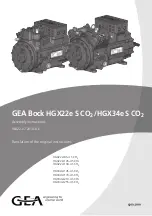
crankcase.
8. Refill the compressor pump with air compressor oil such as SAE-30 non-detergent oil at slow
intervals until the oil reaches the center of the red circle in the sight glass. Use an SAE-10 during
extreme winter conditions.
STORAGE
For storing the air compressor, be sure to do the following:
1. Turn the unit off and unplug the power cord from the receptacle.
2. Remove all air hoses, accessories, and air tools from the air compressor.
3. Perform the daily maintenance schedule.
4. Open the drain valve to bleed all air from the tank.
5. Close the drain valve.
6. Store the air compressor in a clean and dry location.
TROUBLESHOOTING GUIDE
The air compressor should be turned off and unplugged from the power source before any maintenance is
performed as well as the air bled from the tank and the unit allowed time to cool. Personal injuries could occur
from moving parts, electrical sources, compressed air, or hot surfaces.
Problem
Possible Correction
Air leaks at the check valve or at the pressure relief
valve.
A defective check valve results in a constant air leak at the
pressure release valve when there is pressure in the tank and the
compressor is shut off. Drain the tank, then remove and clean or
replace the check valve.
Air leaks between head and cylinder.
Be sure of proper torque on head bolts. If leak remains, contact a
service technician.
Air leak from safety valve.
Operate the safety valve manually by pulling on the ring. If the
valve continues to leak when in the closed position, it should be
replaced.
Pressure reading on the regulated pressure gauge
drops when an accessory is used.
If there is an excessive amount of pressure drop when the
accessory is used, replace the regulator.
NOTE:
Adjust the regulated pressure under flow conditions (while accessory
is being used). It is normal for the gauge to show minimal pressure
loss during initial use of the tool.
Excessive tank pressure.
Move the Auto-On/Off lever to the Off position. If the unit doesn't
shut off, unplug it from the power source and contact a service
technician.
Motor will not start.
Make sure power cord is plugged in and the switch is on. Inspect
for the proper size fuse in your circuit box. If the fuse was tripped
reset it and restart the unit. If repeated tripping occurs, replace the
check valve or contact your service technician.
Excessive moisture in the discharge air.
Remove the water in the tank by draining after each use. High
humidity environments will cause excessive condensation. Utilize
water filters on your air line.
NOTE:
Water condensation is not caused by compressor malfunction.
Be sure the compressor's air output is greater than your tool's air
consumption rate.
Air leaks from the tank body or tank welds.
Never drill into weld or otherwise modify the air tank or it will
weaken. The tank can rupture or explode. Compressor tank cannot
be repaired. Discontinue use of the air compressor.
For any technical questions, please call 1-800-665-8685
6
8132938


























